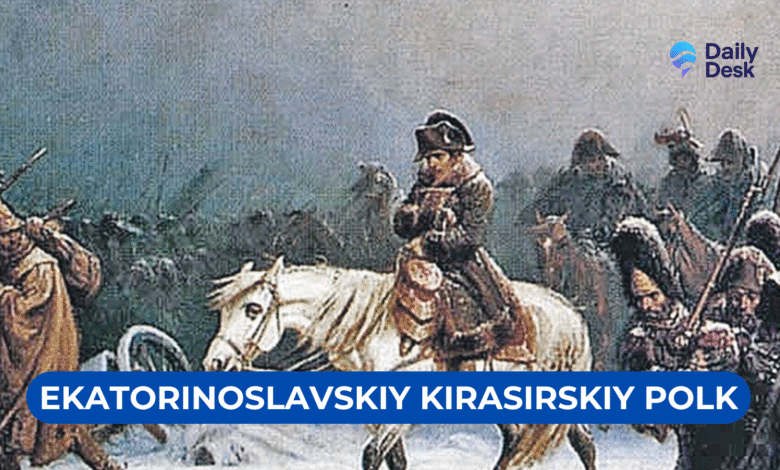The Timeless Story of the Ekaterinoslavskiy Kirasirskiy Polk

The annals of military history are filled with tales of elite units whose names evoke images of courage and discipline. Among these, the Ekaterinoslavskiy Kirasirskiy Polk stands out as a formidable heavy cavalry regiment of the Russian Imperial Army. Its story is not just one of battles won and lost, but a chronicle of evolving military doctrine, political change, and the unyielding spirit of the soldiers who served within its ranks.
From its initial formation to its final days, the history of the Ekaterinoslavskiy Kirasirskiy Polk reflects the grandeur and complexity of the Russian Empire. This regiment, known for its imposing cuirassiers clad in shining armour, participated in some of the most pivotal conflicts of its era. Understanding its journey provides a unique window into the world of 18th and 19th-century European warfare, where cavalry charges could decide the fate of nations.
The Genesis of a Heavy Cavalry Regiment
The origins of the regiment trace back to the military reforms of the 18th century. It was established as part of a broader effort to modernise and strengthen the Russian Imperial Army. The unit was initially formed from existing dragoon regiments, signifying a strategic shift towards creating specialised heavy cavalry capable of breaking enemy lines with overwhelming force.
This formation was a direct response to the military needs of the time. European armies were increasingly reliant on disciplined infantry formations, and a powerful cavalry arm was essential to counter them. The establishment of units like the Ekaterinoslavskiy Kirasirskiy Polk was a testament to Russia’s ambition to maintain its status as a major European military power.
The Role of the Cuirassier
To appreciate the significance of this regiment, one must first understand the role of the cuirassier. These were elite heavy cavalry soldiers, distinguished by the metal breastplate (cuirass) they wore into battle. This armour offered vital protection against sabres and, to some extent, small arms fire, making them a formidable shock troop.
Riding large, powerful horses, the primary function of a cuirassier regiment was to deliver a decisive charge at a critical moment in battle. The thundering sound of a full-strength charge by a unit like the Ekaterinoslavskiy Kirasirskiy Polk was enough to shatter the morale of even the most steadfast infantry. Their impact could turn the tide of an engagement in minutes.
Baptism by Fire: Early Campaigns
The regiment did not have to wait long to prove its mettle. It was soon thrust into the numerous conflicts that characterised the late 18th and early 19th centuries. These early campaigns were crucial in forging the unit’s identity and building its reputation. The soldiers and officers of the Ekaterinoslavskiy Kirasirskiy Polk quickly became seasoned veterans.
Each battle provided valuable lessons in tactics and discipline. The experience gained in these formative years would prove indispensable during the Napoleonic Wars, a period that would define the regiment’s legacy and secure its place in military history. The regiment’s performance in these initial conflicts set a high standard for its future endeavours.
The Napoleonic Wars: A Defining Era
The struggle against Napoleon Bonaparte’s Grande Armée represented the ultimate test for the Russian military. The Ekaterinoslavskiy Kirasirskiy Polk was heavily involved in this continent-spanning conflict, participating in several key battles that shaped the course of the wars.
From gruelling rearguard actions during the initial French invasion to major set-piece battles, the regiment was consistently at the forefront. The troopers of the Ekaterinoslavskiy Kirasirskiy Polk earned widespread recognition for their bravery and resilience against some of the finest cavalry in the world, including Napoleon’s own elite horse riders.
The Battle of Borodino: A Moment of Glory
No account of the regiment is complete without mentioning its role in the Battle of Borodino in 1812. This cataclysmic clash was one of the bloodiest single-day battles of the Napoleonic Wars. During the fierce fighting around the Raevsky Redoubt, Russian cavalry was called upon to counter relentless French assaults.
The Ekaterinoslavskiy Kirasirskiy Polk, as part of a massive cavalry charge, crashed into the French lines with devastating effect. This heroic action helped to stabilise the Russian position at a critical juncture, buying precious time for the infantry to regroup. Though the cost was high, the regiment’s valour at Borodino became legendary. This battle cemented the reputation of the Ekaterinoslavskiy Kirasirskiy Polk as an elite fighting force.
The March to Paris
Following Napoleon’s disastrous retreat from Moscow, the Russian army pursued the remnants of the Grande Armée across Europe. The Ekaterinoslavskiy Kirasirskiy Polk participated in the subsequent campaigns of 1813 and 1814, fighting in Germany and France. This long and arduous advance was a testament to the endurance of its soldiers and horses.
The regiment was part of the triumphant Allied forces that entered Paris in 1814, marking the culmination of a long and bloody war. The sight of Russian cuirassiers in the French capital was a powerful symbol of Napoleon’s defeat and the restoration of the European balance of power. For the Ekaterinoslavskiy Kirasirskiy Polk, it was a moment of ultimate victory.
Life in the Regiment: Uniforms and Equipment
A cuirassier’s appearance was designed to be as intimidating as it was functional. Soldiers of the Ekaterinoslavskiy Kirasirskiy Polk wore elaborate uniforms that denoted their elite status. The most iconic piece of their equipment was the polished steel or iron cuirass, worn over a uniform coat, often in a distinctive colour.
They were typically armed with a heavy straight-bladed broadsword known as a pallasch, designed for powerful thrusting and cutting attacks from horseback. In addition, each trooper carried pistols and sometimes a carbine. Their imposing black leather helmets, often adorned with a crest of horsehair, completed the awe-inspiring image of these imperial knights.
Post-Napoleonic Service and Reorganisation
In the decades following the Napoleonic Wars, the nature of warfare began to change. The increasing accuracy and rate of fire of infantry rifles made massed cavalry charges progressively more hazardous. Military leaders across Europe began to question the utility of traditional heavy cavalry.
The Russian Imperial Army underwent several reforms during this period, and the Ekaterinoslavskiy Kirasirskiy Polk was not immune to these changes. The regiment, like other cuirassier units, saw its role evolve. While the emphasis on shock action remained, there was a growing need for cavalry to perform reconnaissance and screening duties.
The Crimean War and Beyond
The Crimean War (1853-1856) further highlighted the challenges facing traditional cavalry. While the Ekaterinoslavskiy Kirasirskiy Polk was mobilised, the conflict is better remembered for battles like the ill-fated Charge of the Light Brigade, which underscored the vulnerability of horse riders to modern firepower.
In the aftermath, the Russian military accelerated its modernisation efforts. In 1860, a significant reorganisation led to the conversion of most cuirassier regiments into dragoons, who were trained to fight both mounted and on foot. This marked a substantial shift in doctrine for the soldiers of the Ekaterinoslavskiy Kirasirskiy Polk.
Transformation into a Dragoon Regiment
The transition from cuirassiers to dragoons was more than just a name change. It involved new training, new tactics, and a new identity. The iconic cuirass was retired from field service, becoming a purely ceremonial item for parade dress. The regiment was now expected to be more versatile on the battlefield.
This transformation reflected a pragmatic adaptation to the realities of modern combat. The era of the thundering heavy cavalry charge as a primary battle-winning tactic was drawing to a close. The legacy of the Ekaterinoslavskiy Kirasirskiy Polk continued, but in a new form, adapted for a new century.
The Final Chapters: World War I and the Revolution
By the outbreak of World War I in 1914, the cavalry’s role had been further diminished by machine guns, barbed wire, and trench warfare. While cavalry units still saw action in the early, more mobile phases of the war on the Eastern Front, their opportunities for decisive charges were few and far between.
The Ekaterinoslavskiy Kirasirskiy Polk, in its dragoon form, served with the Russian army during this final, devastating conflict. The turmoil of the Russian Revolution in 1917 and the subsequent collapse of the Imperial Army brought an end to the regiment’s long and distinguished history. Like the empire it served, the unit was dissolved, its standards furled for the last time.
The Legacy of the Regiment
Though the Ekaterinoslavskiy Kirasirskiy Polk no longer exists, its legacy endures. It is remembered as a symbol of the power and pageantry of the Russian Imperial Army. Its story offers valuable insights into the evolution of military tactics and the transition from pre-modern to modern warfare.
The memory of the regiment is preserved in military histories, museums, and the detailed work of historical reenactors who strive to recreate the appearance and spirit of these formidable horsemen. Through their efforts, the story of the Ekaterinoslavskiy Kirasirskiy Polk continues to be told.
A Symbol of Courage and Duty
Ultimately, the history of the Ekaterinoslavskiy Kirasirskiy Polk is a human story. It is the story of the thousands of men who served in its ranks, who faced the terror of battle with courage and discipline. From the fields of Borodino to the streets of Paris, their service defined an era. Studying their history is not just an academic exercise; it is an act of remembrance for a legendary unit that left an indelible mark on the pages of history.





